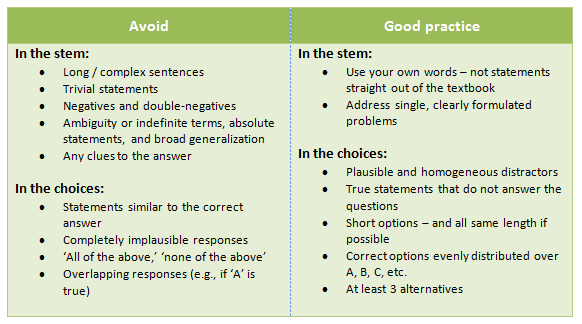Assessment, Quizzes and Gradebook
Types of Questions
Multiple Choice
Multiple choice questions include the question (stem) with multiple possible answers (choices), including the correct answer and several incorrect answers (distractors). In an online quiz, students select the correct answer by clicking the choice they think is correct and the computer stores their answer.

Example
What are distractors in closed types of questions?
A) Elements of the quiz layout that distract attention from the questions
B) Incorrect but plausible choices used in multiple choice questions
C) Unnecessary clauses included in the stem of multiple choice questions
Answer: B)
Feedback:
A) Not quite. Distractors are not related to the format of the quiz.
B) Correct! Distractors the incorrect statements that are used as a choice in multiple choice questions.
C) Distractors are never included in the stem of the question.
Students can generally answer these type of questions quite quickly. As a result, they are often used to test students' knowledge of a broad range of content, mostly factual. Creating these questions can be time consuming because it is often difficult to generate several plausible distractors. However, the marking is automated, which saves instructor time in the long run.
Tips to Write Good Multiple Choice Questions

True / False
True/False questions include one statement which students are asked to identify as true or false.

Example
A True / False question may offer up to four response options.
True
False
Answer: False
Feedback for correct: This statement is indeed false, as a True / False question only offer two options for the answer.
Feedback for incorrect: This statement is False because this type of question only offers two answer choices.
Like multiple choice questions, true/false questions:
- Are usually used to assess basic knowledge of course content and to check for common misconceptions
- Allow students to respond quickly so exams can include a large number to test knowledge of a broad range of content, mostly factual
- Are automatically graded by the computer
True/false questions provide students with a 50% chance of guessing the right answer. For this reason, a larger number of multiple choice questions are often used in quizzes instead of true/false questions.
Tips to Write Good True/False Questions

Matching
Matching questions require learners to pair specific items, such as definitions, with specific concepts.

Example
Match the following question types with their correct definitions:
| A) True / False | 1) Requires learners to pair items |
| B) Multiple Choice | 2) Requires learners to identify statements as true or false |
| C) Matching | 3) Requires learners to select the correct answer from a list of distractors |
Answer: A) - 2); B) - 3); C) - 1)
Feedback: In the case of these types of questions there could be a variety of incorrect answers, difficult to predict. Therefore, it makes more sense to provide students with overall feedback on the question and perhaps some remediation if necessary. True/False questions require learners to identify statements as true or false, while multiple choice questions require students to pick the correct answer from a list of distractors and matching questions require students to pair the list of items provided. If you didn't get this question right, it is important that you review the content on this topic again, or contact your instructor for further clarification.
These questions are generally quick and easy to create and are marked automatically by the computer. However, students typically require more time to answer these questions in comparison to multiple choice or true/false questions.
Tips to Write Good Matching Questions

Fill-in-the-blank
Fill-in-the-blank questions are composed of an incomplete statement for students to complete by typing one or two words that will make the statement correct.

Example
A question that requires students to associate prompts and options is called a ___________ question.
Answer: matching
Feedback for correct: Well done! This is indeed what defines a matching question.
Feedback for incorrect: Not quite... in this type of question students must match the prompts with the option, therefore we call it a matching question.
Tips to Write Good Fill-in-the-blank Questions

Regardless of what type of closed question you choose to use in your course, make sure that you include meaningful and relevant feedback for all the options.